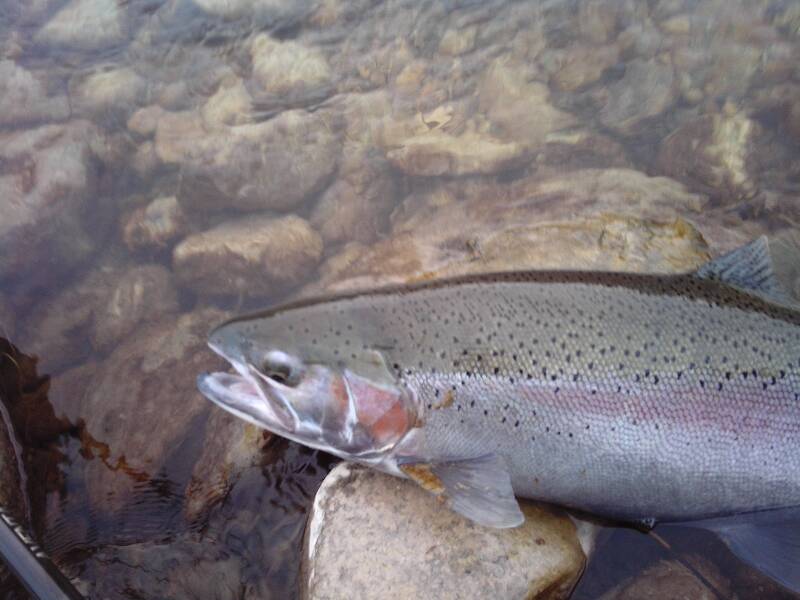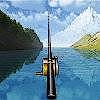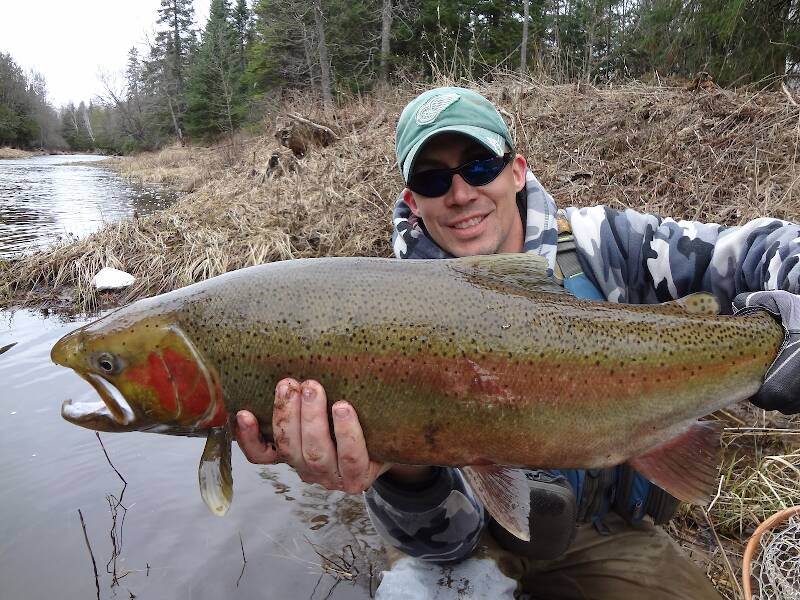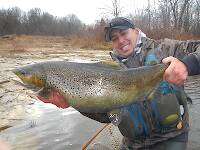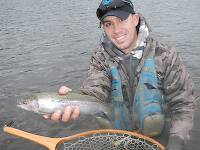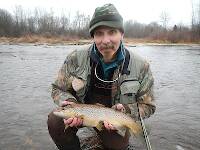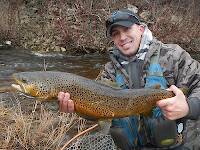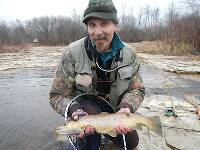
Hex Mayflies
Hexagenia limbata
The famous nocturnal Hex hatch of the Midwest (and a few other lucky locations) stirs to the surface mythically large brown trout that only touch streamers for the rest of the year.
Featured on the forum

This one was surprisingly straightforward to identify. The lack of a sclerite at the base of the lateral hump narrows the field quite a bit, and the other options followed fairly obvious characteristics to Clostoeca, which only has one species, Clostoeca disjuncta.

Troutnut is a project started in 2003 by salmonid ecologist Jason "Troutnut" Neuswanger to help anglers and
fly tyers unabashedly embrace the entomological side of the sport. Learn more about Troutnut or
support the project for an enhanced experience here.
Entoman on Jan 9, 2012January 9th, 2012, 3:59 pm EST
Hi Doublespey,
S. t. morpha trutta is the sub-species of S. trutta that goes to sea, but I say this with a caveat.
As with the insects we love to discuss, the matter of "correct" classification among the trouts (whatever that word means) is far from settled and will probably remain so for some time. I'm musing a bit here, but perhaps this is due to the fact that biologists are still debating what it means to be a "species" in the first place. :) Sorting out differing theories between the "Lumpers" and "Splitters" is always a work in progress. Besides, defining species is not as simplistic as the use of those two terms implies anyway. Discussing sub-species is really jumping into the spinning top.:)
Since ol' Linnaeus started it all in the mid-18th century I think taxonomists have proposed at least 50 sub-species of S. trutta, if memory serves. Some names have come and gone over the years, and unless I miss my guess, many more will be "discovered" in the years to come - especially now that the iron curtain has fallen. Bows and cutts too are going through a lot of revisions. Rainbows aren't even in the Salmo genus anymore. Does that make them pacific salmon? S. salar is more closely related to the brown than the brown is to the rainbow, yet the former is a salmon and the latter two are trout. Makes my head hurt...
TrevorC -
This really gets to the heart of the discussion. Strains and species are two entirely different concepts. In laymen's understanding, the ability to produce fertile offspring is considered the litmus test for determining what constitutes a species. It's not that simple, though. S. trutta has many locations where co-existing strains in the same river or lake have entirely different appearances and they do not interbreed. Paradoxically, the lake dwelling Scottish strain and river dwelling German strain were/are (?) considered sub-species, yet they seem to have mixed in America to the point that calling this specimen a Loch Leven or that one a Von Behr based on appearance is probably inaccurate. Now that they are largely homogenized, I wonder how long it will take for the "American" brown, to "establish" sub-species? According to some criteria, perhaps not long...
...wonder what subspecies the anadromus browns came from?
S. t. morpha trutta is the sub-species of S. trutta that goes to sea, but I say this with a caveat.
As with the insects we love to discuss, the matter of "correct" classification among the trouts (whatever that word means) is far from settled and will probably remain so for some time. I'm musing a bit here, but perhaps this is due to the fact that biologists are still debating what it means to be a "species" in the first place. :) Sorting out differing theories between the "Lumpers" and "Splitters" is always a work in progress. Besides, defining species is not as simplistic as the use of those two terms implies anyway. Discussing sub-species is really jumping into the spinning top.:)
Since ol' Linnaeus started it all in the mid-18th century I think taxonomists have proposed at least 50 sub-species of S. trutta, if memory serves. Some names have come and gone over the years, and unless I miss my guess, many more will be "discovered" in the years to come - especially now that the iron curtain has fallen. Bows and cutts too are going through a lot of revisions. Rainbows aren't even in the Salmo genus anymore. Does that make them pacific salmon? S. salar is more closely related to the brown than the brown is to the rainbow, yet the former is a salmon and the latter two are trout. Makes my head hurt...
TrevorC -
I believe there are many different strains/species of brown trout. I believe that many different species change with their environment and diet.
This really gets to the heart of the discussion. Strains and species are two entirely different concepts. In laymen's understanding, the ability to produce fertile offspring is considered the litmus test for determining what constitutes a species. It's not that simple, though. S. trutta has many locations where co-existing strains in the same river or lake have entirely different appearances and they do not interbreed. Paradoxically, the lake dwelling Scottish strain and river dwelling German strain were/are (?) considered sub-species, yet they seem to have mixed in America to the point that calling this specimen a Loch Leven or that one a Von Behr based on appearance is probably inaccurate. Now that they are largely homogenized, I wonder how long it will take for the "American" brown, to "establish" sub-species? According to some criteria, perhaps not long...
"It's not that I find fishing so important, it's just that I find all other endeavors of Man equally unimportant... And not nearly as much fun!" Robert Traver, Anatomy of a Fisherman
Fishfins on Jan 11, 2012January 11th, 2012, 4:44 pm EST
i guess it's like your rainbows the real true rainbows (some people call them lepard rainbows)and u have your steelhead which were stocked many years ago!i could go on all night about diferent types of this and different types of that all it really matters is that u hit fish or not in my books but it is always nice to know the truth of the matter!
Jmd123 on Jan 12, 2012January 12th, 2012, 9:28 am EST
Since this thread has restarted as of late, I will just mention again two of James Prosek's books, "Trout: An Illustrated History" and "Trout of the World" to those interested in the diversity of salmonids. I believe he corresponds regularly with Dr. Robert Benkhe (spelling?), considered a leading expert on salmonid taxonomy, for the taxonomic discussion & nomenclature in his books. They're quite beautifully illustrated as well!
Jonathon
Jonathon
No matter how big the one you just caught is, there's always a bigger one out there somewhere...
Entoman on Jan 12, 2012January 12th, 2012, 10:04 am EST
There is also a book I read a few years back that is a compilation of Dr. Behnke's (correct spelling) various articles. It is also full of beautiful illustrations by Joe Tomelleri (he did the beautiful trout illustrations for Ralph Cutter's "Sierra Trout Guide", if I remember correctly). I don't remember the title, but it is excellent.
Though a bit dated and with most illustrations in black and white, Schwiebert's opus "Trout" also covers this topic very well. Of particular interest is information on many exotic salmonids most anglers have never heard of. Another good thing is the writing is full of angling antecdotes that help the dry science go down easier.
Though a bit dated and with most illustrations in black and white, Schwiebert's opus "Trout" also covers this topic very well. Of particular interest is information on many exotic salmonids most anglers have never heard of. Another good thing is the writing is full of angling antecdotes that help the dry science go down easier.
"It's not that I find fishing so important, it's just that I find all other endeavors of Man equally unimportant... And not nearly as much fun!" Robert Traver, Anatomy of a Fisherman
Doublespey
Posts: 61
Posts: 61
Doublespey on Jan 13, 2012January 13th, 2012, 4:09 am EST
In regards to the rainbow trouts Taxonomy change.....As I distinctly remember, unfortunately, the West Coast Native Americans that were allowed to commercially net steelhead were having trouble selling steelhead,(rainbow trout) in EastCoast markets. for example. The steelhead's official taxonomy was changed, and the rainbow(steelhead) were called "Summer Salmon" (summer-run steelhead) in the Eastern markets. Hence they sold a lot better.
That's when I gave up on any interest in Taxonomy.
That's when I gave up on any interest in Taxonomy.
Jmd123 on Jan 14, 2012January 14th, 2012, 2:05 pm EST
Kurt: thanks for the spelling correction, sir.
Doublespey: fish marketers are infamous for calling a fish whatever name they can get away with - hence the Patagonian toothfish gets sold as "Chilean sea bass", a fish that not only doesn't exist but the fish in question is not even related to sea bass...and I have seen "steelhead" for sale in plenty of fish markets in this part of the world (Michigan).
Jonathon
Doublespey: fish marketers are infamous for calling a fish whatever name they can get away with - hence the Patagonian toothfish gets sold as "Chilean sea bass", a fish that not only doesn't exist but the fish in question is not even related to sea bass...and I have seen "steelhead" for sale in plenty of fish markets in this part of the world (Michigan).
Jonathon
No matter how big the one you just caught is, there's always a bigger one out there somewhere...
Czoom on Jan 14, 2012January 14th, 2012, 4:32 pm EST
Also depends where you catch them from. Like all trout browns varie in colors.
Doublespey
Posts: 61
Posts: 61
Doublespey on Jan 14, 2012January 14th, 2012, 5:18 pm EST
jmd123...Yes the markets are famous for that, BUT, the govt decided to cooperate with the Natives, and changed the steelhead's official taxonomy to salmon, no longer trout.
Oldredbarn on Jan 14, 2012January 14th, 2012, 7:48 pm EST
In regards to the rainbow trouts Taxonomy change.....As I distinctly remember, unfortunately, the West Coast Native Americans that were allowed to commercially net steelhead were having trouble selling steelhead,(rainbow trout) in EastCoast markets. for example. The steelhead's official taxonomy was changed, and the rainbow(steelhead) were called "Summer Salmon" (summer-run steelhead) in the Eastern markets. Hence they sold a lot better.
That's when I gave up on any interest in Taxonomy.
I'm not sure what this piece of misinformation is all about. See "The Wildlife Series: Trout" edited by Judith Stolz & Judith Schell published 1991 pages 304-306 explaining the classification of the Rainbow and the history of the changes in this classification.
I'm not going to type all this for you, but the bottom line is that from 1792 when Johann Walbaum first discribed the fish from samples taken from the Artic and named it Salmo mykiss, it morphed to Salmo gairdneri which most of us remember to Oncorhynchus mykiss. Due to the science, genetics, etc it was found that the fish was not so related to salmon and Salmo of the Atlantic basin and Europe...
So, it went from "salmon" to something more unique to the Pacific watersheds...Not the other way around as I think described above, from Rainbow to salmon, so it could be better marketed in the east..."Taxonomy" has little to do with marketing or they wouldn't make it so damn complicated! :)
For the time being it is not Salmo anything...
If I'm missing something here please clue me in...I think that passing on something that may not be supported, say in a scientific manner, and instead, is as someone "distinctly remembers it", is perhaps a bit weak...
As of 1991 there were 4 sub-species generally accepted...Which leads in to what I think Kurt was hinting at in his post above...It's a work in progress, no doubt! "The scienific classification of rainbow trout has had a long and turbulent history" p304 see above.
Spence
"Even when my best efforts fail it's a satisfying challenge, and that, after all, is the essence of fly fishing." -Chauncy Lively
"Envy not the man who lives beside the river, but the man the river flows through." Joseph T Heywood
"Envy not the man who lives beside the river, but the man the river flows through." Joseph T Heywood
Doublespey
Posts: 61
Posts: 61
Doublespey on Jan 14, 2012January 14th, 2012, 8:35 pm EST
You for sure are more into the context, and accuracy of the rainbow change. I was directly involved in the commercialization of the steelhead, rainbow trout, and its being marketed as summer salmon so that they could better be sold. During that same time period it was noted in the Seattle papers that the taxonomy of the steelhead had been changed to a salmon. None of we steelheaders cared to get into the background regarding the change at the time, just made the association between the marketing, and the govts apparent desire to see they were marketed correctly...it appeared to us anyway. Appears we were wrong.
Entoman on Jan 15, 2012January 15th, 2012, 2:01 am EST
Jonathon -
Ha! You got that right... My wife once brought home some fish from the local monger that was labeled as "Buffalo Fish". He described it to her as being firm, flaky and sweet. I didn't think much of it and liked it even less when I found a "U" shaped bone, if you catch my drift.:)
Spence -
While Walbaum may have been responsible for the first description recognized by the Brits in recently established Linnaean taxonomy, Spanish naturalists in CA described them more than a century before. In those days, there wasn't much love lost between the English and Dominican/Franciscan missionaries.:)
Jere -
You are right about steelhead being listed with salmon by the government. We had the same issue with the tribes on the Klamath. The government didn't change the taxonomy though, it just recognized the taxonomy as currently understood and so conveniently placed them in the same category for regulatory (political) purposes. Like pale morning dun - steelhead, trout, and salmon are common names not scientific ones and I think we are getting them a little confused here. There are four genera of salmonids we are concerned with as anglers in North America:
1. Salmo - Brown Trout and Atlantic Salmon
2. Salvelinus - Brook Trout, Lake Trout, Arctic Char, Bull Trout, Dolly Varden, etc.
3. Oncorhynchus - Rainbow trout (steelhead), Cutthroat Trout, Pacific Salmon (Silver, Chum, Pink, Sockeye, King, etc).
4. Thymallus - Grayling
Trout is just a common name that some Englishman came up with to describe the little brown ones that seemed to hang about. Another Englishman came up with salmon for the big silver ones that never hung around and only came back to make babies. The latter was derived from what his Roman master called them. We just applied the name "trout" to our species of small salmonids that seemed to hang about as well. It has no bearing on their actual relationships. The next time some wise guy reminds you that "brookies aren't trout, they're char", you can really cook his noodle by pointing out that scientifically speaking there's no such thing as trout and that brookies can be called trout as much as any other species of salmonid:)
Hey guys, I have an idea! Since the latest generation of anglers is so fond of converting scientific names to abbreviated common names for insects, why not fish? If Hex, Flav, and Trico work, why not Salm, Salv, and Oncor? Forget the romantic common names of the past. I love fishing a Trico hatch when Oncors are rising. Salms and Salvs like 'em too. Doesn't that have a nice sound to it? Like nails on a chalkboard...;)
... fish marketers are infamous for calling a fish whatever name they can get away with...
Ha! You got that right... My wife once brought home some fish from the local monger that was labeled as "Buffalo Fish". He described it to her as being firm, flaky and sweet. I didn't think much of it and liked it even less when I found a "U" shaped bone, if you catch my drift.:)
Spence -
While Walbaum may have been responsible for the first description recognized by the Brits in recently established Linnaean taxonomy, Spanish naturalists in CA described them more than a century before. In those days, there wasn't much love lost between the English and Dominican/Franciscan missionaries.:)
Jere -
You are right about steelhead being listed with salmon by the government. We had the same issue with the tribes on the Klamath. The government didn't change the taxonomy though, it just recognized the taxonomy as currently understood and so conveniently placed them in the same category for regulatory (political) purposes. Like pale morning dun - steelhead, trout, and salmon are common names not scientific ones and I think we are getting them a little confused here. There are four genera of salmonids we are concerned with as anglers in North America:
1. Salmo - Brown Trout and Atlantic Salmon
2. Salvelinus - Brook Trout, Lake Trout, Arctic Char, Bull Trout, Dolly Varden, etc.
3. Oncorhynchus - Rainbow trout (steelhead), Cutthroat Trout, Pacific Salmon (Silver, Chum, Pink, Sockeye, King, etc).
4. Thymallus - Grayling
Trout is just a common name that some Englishman came up with to describe the little brown ones that seemed to hang about. Another Englishman came up with salmon for the big silver ones that never hung around and only came back to make babies. The latter was derived from what his Roman master called them. We just applied the name "trout" to our species of small salmonids that seemed to hang about as well. It has no bearing on their actual relationships. The next time some wise guy reminds you that "brookies aren't trout, they're char", you can really cook his noodle by pointing out that scientifically speaking there's no such thing as trout and that brookies can be called trout as much as any other species of salmonid:)
Hey guys, I have an idea! Since the latest generation of anglers is so fond of converting scientific names to abbreviated common names for insects, why not fish? If Hex, Flav, and Trico work, why not Salm, Salv, and Oncor? Forget the romantic common names of the past. I love fishing a Trico hatch when Oncors are rising. Salms and Salvs like 'em too. Doesn't that have a nice sound to it? Like nails on a chalkboard...;)
"It's not that I find fishing so important, it's just that I find all other endeavors of Man equally unimportant... And not nearly as much fun!" Robert Traver, Anatomy of a Fisherman
Doublespey
Posts: 61
Posts: 61
Doublespey on Jan 15, 2012January 15th, 2012, 4:21 am EST
Entoman...excellent post, and something a country boy like me can understand.
That guy that always said a brookie wasn't a trout was always me.
That guy that always said a brookie wasn't a trout was always me.
PaulRoberts on Jan 15, 2012January 15th, 2012, 9:34 am EST
An interesting tidbit:
The "salmon", "steelhead" included, can be seen as ones that have evolved obligate anadromy, while "trout" are the more upland resident popns that are more "obligate residents". But, within the "trout" and "char" this is not so clear cut.
Interestingly, some studies on European "seatrout" (and arctic char) have shown that anadromous and resident individuals can come from the very same redd, though some popns have a greater propensity to "go migratory". This is also seen in many West Coast rainbow and cutthroat popns, and in Eastern brook trout (Salv's, lol) called locally, "coasters".
I see a similar dichotomy of behavior in brown and rainbow trout commonly here in the states too. In the browns, what I don't believe I've seen is actual "smoltification", which both "seatrout" and "salmon" do just prior to migration. Our eastern rainbows, of mixed resident and "steelhead" stocks, do smoltify -which I've seen. I've also seen Atlantic salmon smolts, when they were experimentally introduced into Lake Ontario tribs.
Now... resident browns do "go migratory" on a more limited basis in most streams I've fished, and they do take on a nearly "pelagic silver" during this time. Smoltification may be more hard wired in the anadromous "salmon" and more environmental in cause in "trout". This is my present understanding, and I'm not up on the latest; Likely much more has been done there.
The "salmon", "steelhead" included, can be seen as ones that have evolved obligate anadromy, while "trout" are the more upland resident popns that are more "obligate residents". But, within the "trout" and "char" this is not so clear cut.
Interestingly, some studies on European "seatrout" (and arctic char) have shown that anadromous and resident individuals can come from the very same redd, though some popns have a greater propensity to "go migratory". This is also seen in many West Coast rainbow and cutthroat popns, and in Eastern brook trout (Salv's, lol) called locally, "coasters".
I see a similar dichotomy of behavior in brown and rainbow trout commonly here in the states too. In the browns, what I don't believe I've seen is actual "smoltification", which both "seatrout" and "salmon" do just prior to migration. Our eastern rainbows, of mixed resident and "steelhead" stocks, do smoltify -which I've seen. I've also seen Atlantic salmon smolts, when they were experimentally introduced into Lake Ontario tribs.
Now... resident browns do "go migratory" on a more limited basis in most streams I've fished, and they do take on a nearly "pelagic silver" during this time. Smoltification may be more hard wired in the anadromous "salmon" and more environmental in cause in "trout". This is my present understanding, and I'm not up on the latest; Likely much more has been done there.
Pryal74 on Jan 15, 2012January 15th, 2012, 11:47 am EST
As far as the Brown Trout are concerned, I read and noticed many variations. However, Brown Trout that are from a hatchery are known to have less red spots or markings. The natural reproduction strains have (from observations and studies) more red markings (spots and on the adipose fin) and also that blue mark behind their eye. Look in your photos and pictures of the Salmo Trutta river resident species. In just a single river I fish, I have noticed a huge disparity in markings, colors and patterns. One constant is the red being more prevalent on wild or second generation or beyond fish. Another tell-tale sign is the fuller and more developed fins. That's in no way an expert opinion, just what I have read, studied and observed.
-James Pryal
Into The Wild Fly Fishing
Into The Wild Fly Fishing
Quick Reply
Related Discussions
Topic
Replies
Last Reply



